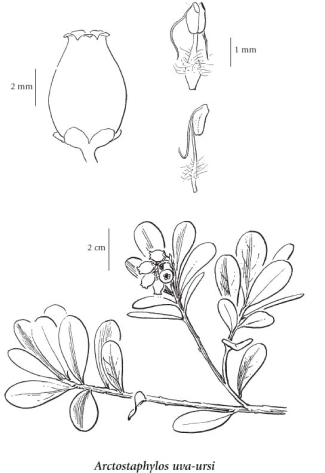kinnikinnick (common bearberry; mealberry; sandberry)
Ericaceae (Crowberry family)
Introduction to Vascular Plants
Photograph click to collapse contents
© Larry Halverson (Photo ID #57379)
Introduction click to expand contents
Kinnikinnick is a widespread circumpolar submontane to subalpine shrub species (Klinka et al. 1989). In North America, it is found from California north to Alaska, across Canada and the northern US, and throughout the Rocky Mountains from Canada to New Mexico (Crane 1991). In British Columbia, it is found across the province in "dry forests and exposed, often rocky, sites in the lowland to lower alpine zones" (Douglas et al. 1999). It is frequently a dominant understory species in open pine forests where it grows best in high light situations (but will sometimes tolerate shade) (Crane 1999). Klinka et al. (1998) indicate that in coastal BC it is "common in open-canopy, young, seral lodgepole pine forests on shallow soils, soils on rock outcrops and strongly drained coarse-skeletal soils on watershedding sites". It is a fire-tolerant species (short fire cycles, low fuel buildup) and may be a "seedbanking species with fire resistant seed" (Crane 1999).
This common BC species is an evergreen prostrate shrub species with leathery dark green leaves that produces trailing stems and can form broad mats. Flowers are pink and bell-shaped; fruits are bright red 'berries' (drupes). Roots on dry sites are reported up to 181 cm (Crane 1991). It is clonal and, although seedlings are produced, reproduction is primarily asexual (Crane 1991). Detailed information on this species is provided in the Fire Effects Information System database. |
Species Information click to expand contents
General:
Prostrate shrub with somewhat stoloniferous rooting stems, sometimes forming mats several meters wide; bark reddish to brownish, peeling off; stems ascending at the tip, 5-15 cm tall, minutely hairy, sometimes glandular.
Leaves:
Alternate, evergreen, leathery, egg- to spoon-shaped, 1-3 cm long, 0.3-1.2 cm wide, rounded at tip, rarely pointed, narrowed basally, entire, glabrous to minutely hairy especially on the margins and midrib, dark green above, paler below; stalks 2-5 mm long.
Flowers:
Several in few-flowered terminal clusters; flower stalks 2-5 mm long, straight or curved, borne in the axils of hairy bracts; corollas pinkish-white, urn-shaped, 4-6 mm long, 5-lobed; calyces 1-1.5 mm long.
Fruits:
Berries, bright red, 5-10 mm wide.
Notes:
In 1974, Packer and Denford reviewed the classification of infraspecific taxa, found it to be inadequate, and proposed that four subspecies and two varieties be recognized. Two of the subspecies were new taxa, not previously described. The taxa were based on the type of hairiness found on the young branches and stalks, chromosome numbers, and phenolics. All four subspecies occur in BC, but are not geographically distinct. We have, therefore, decided not to recognize these taxa until further work is done on the taxonomy and distribution of these entities in BC.
Illustration click to expand contents

If more than one illustration is available for a species (e.g., separate illustrations were provided for two subspecies) then links to the separate images will be provided below. Note that individual subspecies or varietal illustrations are not always available.
Illustration Source: The Illustrated Flora of British Columbia
USDA Species Characteristics click to expand contents
Flower Colour:
Purple
Blooming Period:
Late Spring
Fruit/Seed characteristics:
Colour: Red
Present from Summer to Fall
According to the USDA, this species is a known allelopath.
Source: The USDA
Ecology click to expand contents
The table below shows the species-specific information calculated from
original data (BEC database) provided by the BC Ministry of Forests and Range.
(Updated August, 2013)
| Site Information |
Value / Class |
||
|
Avg |
Min |
Max |
|
| Elevation
(metres) |
1129 | 6 | 2854 |
| Slope
Gradient (%) |
23 | 0 | 244 |
|
Aspect (degrees) |
192 | 0 | 360 |
| Soil
Moisture Regime (SMR) [0 - very xeric; 4 - mesic; 8 - hydric] |
2 | 0 | 8 |
| Modal
Nutrient Regime
Class |
C | ||
| #
of field plots species was recorded in: |
5666 | ||
| Modal
BEC Zone Class |
IDF | ||
|
All BEC Zones (# of stations/zone) species was recorded in |
AT(42), BAFA(22), BG(17), BWBS(321), CDF(6), CMA(2), CWH(92), ESSF(497), ICH(472), IDF(1759), IMA(10), MH(10), MS(909), PP(190), SBPS(464), SBS(502), SWB(87) | ||
|
Source:
Klinkenberg 2013
|
|||
Habitat and Range click to expand contents
Status Information click to expand contents
Synonyms click to expand contents
Synonyms and Alternate Names:
Arctostaphylos adenotricha (Fernald & J.F. Macbr.) A. Löve & D. Löve & Kapoor
Arctostaphylos nevadensis var. coloradensis (Rollins) Harrington
Arctostaphylos uva-ursi subsp. adenotricha (Fernald & J.F. Macbr.) Calder & Roy L. Taylor
Arctostaphylos uva-ursi subsp. coactilis (Fernald & J.F. Macbr.) A. Löve & D. Löve
Arctostaphylos uva-ursi subsp. coloradensis (Rollins) J.B. Roof
Arctostaphylos uva-ursi subsp. longipilosa Packer & Denford
Arctostaphylos uva-ursi subsp. monoensis J.B. Roof
Arctostaphylos uva-ursi subsp. myrtifolia (Parry) J.B. Roof
Arctostaphylos uva-ursi subsp. stipitata Packer & Denford
Arctostaphylos uva-ursi subsp. uva-ursi
Arctostaphylos uva-ursi var. adenotricha Fernald & J.F. Macbr.
Arctostaphylos uva-ursi var. coactilis Fernald & J.F. Macbr.
Arctostaphylos uva-ursi var. leobreweri J.B. Roof
Arctostaphylos uva-ursi var. marinensis J.B. Roof
Arctostaphylos uva-ursi var. pacifica Hultén
Arctostaphylos uva-ursi var. saxicola J.B. Roof
Arctostaphylos uva-ursi var. stipitata (Packer & Denford) Dorn
Arctostaphylos uva-ursi var. suborbiculata W. Knight
Uva-Ursi uva-ursi (L.) Britton